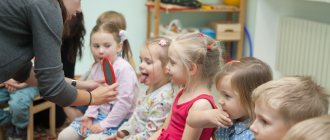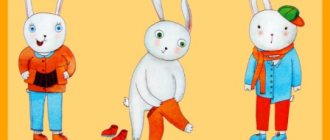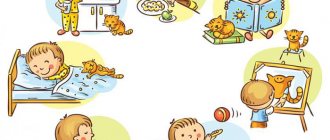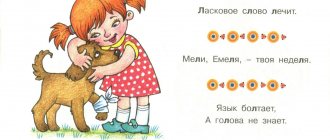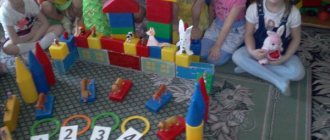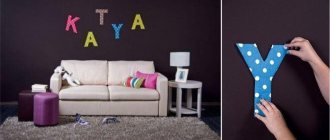Developmental classes for children aged 2-3 years are a very important period for mastering speech, pronunciation of vowels and consonants, enriching vocabulary and developing the grammatical structure of speech.
In the third year of a child’s life, speech develops in the process of objective, cognitive activity, during games, activities and communication. Therefore, constant verbal accompaniment of the child’s actions during classes and in everyday life is very important.
Communication between adults and children contributes to the development of coherent speech and the accumulation of experience, the ability to express a thought, feeling, desire, consisting of several sentences.
Children develop the ability to answer questions and ask questions. Shared speech is practiced.
The technique when an adult begins a phrase or rhyme and the child completes it provides important psychological comfort.
“Mustachioed, furry”
Goal: to develop speech understanding and hearing, articulatory apparatus, and expand vocabulary. Material: basket, toy cat, napkin.
Class
Place the cat in the basket. Cover it with a napkin.
Show the basket to the child and ask him questions: “Who came to visit us? Who is that purring like that?”
Look into the basket together and take out a toy.
The cat turns to the child: “I am Murka, gray fur coat, soft paws, fluffy tail, sharp claws. Meow meow. What is your name? Pet me."
Stroke the cat, saying: “The cat has a mustache, loves milk, purrs songs. How does a pussy meow? (meow-meow) Pussy washes itself not with water, but with its paws"
Read the nursery rhyme:
- Oh, you little cat, Cool little one! Play with me, little cat, with Masha, the young cat!
Place the cat on the floor and play with the plot that she is lying on the path and does not want to leave.
Tell the pussy: “Scram! Don’t sit on the path!” Wag your finger.
Repeat the game several times, gesturing expressively.
“A rooster walks around the yard”
Goal: to develop speech understanding and hearing, the articulatory apparatus, and to activate verbs. Materials: toy cockerel, scarf.
Class
Bring a toy covered with a scarf into the room.
Say: “Ku-ka-re-ku!”
Find out - did the child guess who came to visit?
Ask: “Who sings like that? Ku-ka-re-ku!
Remove the scarf and show off the toy.
Look at the cockerel together: a red comb, a bright tail, strong legs with spurs, and what a clear voice he has!
Find out how the cockerel wakes everyone up in the morning?
Ask, how does he flap his wings, rake the ground with his paws, look for food, call hens and chicks?
Demonstrate the actions of a cockerel with a toy.
And then ask the child to repeat the movements himself, helping, expressing the actions in words.
Play, stimulate interest, an emotionally positive attitude towards the game.
Lesson notes for young children
Lesson for young children
"Journey through the Land of Sand"
Target:
development of the cognitive and emotional-volitional sphere of young children
Tasks:
Introduction to sand painting techniques
Reduction of psychophysical stress
Development of fine motor skills and tactile-kinesthetic sensitivity
Greetings
Teacher:
“Children, today we will go to one very amazing place - Sand Country. And our magic parachute will help us with this."
Magic music sounds. Mommies take a parachute, and children hide. Sand painting tables included.
Warm-up
Teacher: "
So we found ourselves in a fairyland. Look. How empty and sad it is here. One sand. But this is not ordinary sand. He's magical. He can feel touch. Hear your speech. Speak with you. Let's say hello to him.
— Place your palms on the sand and say “Hello, magic sand!”
- Take sand into your hands and rub it between your palms. What is he like?
- Sprinkle sand from palm to palm,
- Bury your mother’s hand in the sand, and now your mother will bury your hand.
— Now let’s put sand in our fists and together with mom we fill the surface of the light table
-This used to be a magical Sand Country:
With high mountains (we draw mountains on a sand table with clenched fists)
Using deep rivers (with comb fingers we draw river waves)
Beautiful forests (we draw trees on the table with clenched fists and branches with our fingers),
- But an evil wizard came and bewitched the sandy country!
A hurricane has hit (we collect sand into our fists and through our fingers, rotating our fists and opening our fingers, pour sand through them),
It began to rain heavily (we turn our fists over, open our palms and pour sand through our fingers),
And suddenly the rain turned into snow (we pick up sand in our fists and with a sharp movement throw it onto the sand table - in the form of snowballs),
And then the sorcerer himself appeared, look how big his eyes are (with two palms, we draw the sorcerer’s eyes on the sand).
Let's tickle him
And he began to smile. And he became our little friend.
Main part
The Sandman (doll) appears to meet the children and parents.
Sandman:
“You are all so good. Did you know that in Sand Country you can draw whatever you want?
- I'll try to teach you this. Shall we try together? Children's answers.
- Let's draw the sun. Draw a circle with your finger, and then draw rays of the sun
“Oh, what a great fellow, look how beautiful our suns turned out.”
There is a knock on the door.
Teacher:
“Someone else came to us”
Music plays, a bear (toy) appears
"Dog"
Goal: to develop speech understanding and hearing, the articulatory apparatus, to activate verbs and nouns, to create conditions for initiative statements. Materials : dog toys.
Class
Place the toy in a visible place. Give your child a riddle:
You stroke and he caresses, You tease and he bites.
Ask: “Who is this?”
Play out the story-based dating game, “Aw-aw! Hello! Let's get acquainted. I'm Sharik. And what's your name?"
Encourage your child to say his name and pet the dog.
Look at the toy together: the ears are upright, the tail is ringed, and how does it sound? What can a dog do?
Demonstrate the dog's actions with a toy: runs, jumps, barks, lies down, rejoices when you meet him, wags his tail.
Encourage your child to play with the toy.
Address the dog: “You, little dog, don’t bark, don’t scare our children.”
Let the baby play with the dog, making emotional sounds and proactive statements.
"Early, early in the morning"
Goal : develop speech hearing, articulatory apparatus, pronounce words and expressive movement, encourage proactive statements. Material: toys: pipe, cow.
Class
Show your child the pipe and demonstrate how it plays. Ask: “How does the pipe sing? Doo-doo-doo.” Repeat the sounds and movements with your child.
Play out a story game in which a shepherd boy uses his pipe to collect cows. “How does the shepherd play the pipe? Doo-doo-doo"
Read the poem:
Early - early in the morning The shepherd tu-ru-ru-ru! And the cows chanted in harmony with him: “Moo-mu-mu!
How does a cow moo? Mu-mu-mu - together.
Ask: “Where are the cow’s ears? Eyes? Horns?" Correlate words and gestures, touching parts of the body, expressing conditional actions.
Tell your child about the cow: what does it eat, what benefits does it bring to people, where and how does it sleep? What does the baby know about her? Help and encourage him to speak up and express his thoughts.
Development of memory, logic
At this age, it is important to consolidate and improve knowledge about shapes and colors, sizes, and quantitative indicators. Develop an understanding of the seasons and time of day.
Place objects of various shapes and colors in a box. Ask the baby to give only round objects, then only red objects.
Place beans and beans or buttons of various sizes into a plate. Ask to sort small and large items.
Place various items in a box, ask them to place fruits and animals separately.
Currently, there are many games that help develop memory and thinking. These are all kinds of lotto with shapes, colors, animals, vegetables and other objects, games in which the task is to find identical objects, find a pair, various puzzles. Children willingly play such games and remember the names of objects and their characteristics.
"On a horse"
Goal: to develop speech hearing, articulatory apparatus, to encourage proactive statements, to cause imitation of the speech of an adult. Material: rocking horse toy.
Class
Show the child the horse, let him pet it, ask: “Who came galloping to us?” Horse! She has a long mane and tail, graceful posture and hooves. Eeyore! The horse clatters its hooves: clop-clop-clop. Noooo! And she galloped away.” Accompany the words with expressive actions together with the child. Repeat the story game. Ask your child to describe the horse, show parts of the body, pronounce sounds in his voice, imitating the animal. Put him on a rocking horse, saying: “Noooo, let’s go!” Accompany onomatopoeia with expressive movements.
Tell us about the horse: what it eats, what benefits it brings to humans and where it lives.
"Little Mouse"
Goal: to develop speech hearing, articulatory apparatus, pronounce words and expressive movements, and cause imitation of the speech of an adult. Materials: toy mouse, napkin, basket.
Class
Show your child a basket covered with a napkin in which a mouse sits. Suddenly an onomatopoeia is heard: “pi-pi-pi.” Ask your child: “Who’s that squeaking there? Who casts a vote? Small, gray, lives in a hole, gnaws on crusts.” A mouse appears. Continue the story game: “I’m a mouse, I’m afraid of a cat.” Describe the mouse: gray, small, long tail, sharp claws. Accompany your words with expressive movements. “What’s that on the mouse? How does she run? What does it eat? Where does he live? Where does he hide from the cat?
Practice joint speech: start a phrase, and the child completes it. This technique helps children learn to speak freely.
Norms for children from 2 to 3 years old
Starting from the age of two, a child’s speech base is formed, so at this age it is important to pay special attention to the development of his speech.
Speech norms for children 2-3 years old can be considered:
- After a child turns two years old, his vocabulary is at least 200 words. Moreover, after the two-year mark, the stock begins to grow rapidly and after six months it should be equal to 1000 words. The main part of the stock is nouns, there should be a little less verbs. At three years old, a child should actively include pronouns, prepositions, conjunctions, adjectives, and adverbs in his speech.
- From the age of two, a child can construct three-word sentences, can already explain his desires and basic needs, and easily communicates with peers. Most sentences are declarative; exclamatory sentences are less common. Interrogative sentences often consist of one or two words.
- Children from the age of two and a half begin to characterize objects: name their size, color, taste, express impressions of events or objects (but still in monosyllabic sentences).
- Generalizing words are observed in speech. For example, tomato and cucumber are vegetables; boots and shoes are shoes.
- Words of two or more repeated syllables (for example, “too-too” or “bee-bee”) should no longer be present in speech.
- The speech of an adult should already be fully perceived by the child. In addition, the baby begins to express his reaction to the elders’ treatment.
- At two years old, mistakes are still made in declension of words, agreement of genders and numbers. At the age of three, these errors are eliminated.
- It is possible to replace letters or entire syllables in words ("patka" instead of "shovel" is allowed).
- At two years old, there is nothing wrong with replacing hissing letters with whistling ones, as well as hard ones with soft ones. But already at three years old, many children pronounce even the most difficult sounds - r and l.
REFERENCE! The most important thing in the development of a baby’s speech is communication with adults.
Also note that girls have a larger vocabulary than boys. This is not considered a deviation. Kids easily learn small poems and are able to recite them with emotion.
"Goat"
Goal: to develop speech hearing, articulatory apparatus, pronounce words and expressive movements, and expand vocabulary. Materials: goat toy.
Class
Take a toy and start a dialogue:
-Who came to us? The goat is horned, butted. Don't be afraid of the goat, but let's talk to her. Say: “Hello, little goat! We are glad to see you!”
Encourage your child to express his initiative.
- What does the goat give us? Milk? Where's your cup? Substitute and drink warm milk!
Imitate conditional actions.
- Tell her thank you for the tasty and healthy milk. Where are the goat's eyes? Horns?
Give your child the opportunity to show all parts of the body, encouraging action.
-Where does the goat graze? What does he eat? How does she run? How does he cast his voice?
In the process of communication, the child develops grammatical speech, pronunciation of vowels, whistling sounds and simple consonants.
"Teddy Bear"
Goal: to develop speech hearing, articulatory apparatus, pronounce words and expressive movements, and expand vocabulary. Materials: bear toy.
Class
Take the bear and play the story game. Give your child a riddle:
Who is the biggest in the forest, Who is rich and wears fur? Who picks raspberries from the branches, Who loves fragrant honey?
- Who came to visit us? Bear. Hello! Where are the bear's eyes? Ears? Paws?
Encourage your child to express his initiative.
-How does Mishka walk and waddle? Show me. How does he voice?
Pronounce sounds accompanied by expressive movements.
- What does Mishka like to eat? Show him how he puts his paws up to accept the treat.
Make expressive movements together.
— What does Mishka enjoy? Honey and raspberries. Where does he get them? In the forest?
Ask questions, involving your child in an interesting game, developing speech and expanding familiarity with the world around him.
Consultation for parents. Speech development of children 2-3 years old
Lessons should be short, theatrical and rich in games. At first, in order to strictly follow the plan and not be led by the child, it is better to prepare a detailed outline.
Complex of articulation gymnastics for children 4-5 years old in the middle group
A variety of speech therapy books, coloring books and other teaching materials provide great help during the classes. There are manuals on the World Wide Web that can be printed and used in home games.
Additional Information. Class notes can be found in the book by O.E. Litvinova “Speech development of young children.” Compiled strictly according to the Federal State Educational Standards program based on the author’s many years of experience, all the exercises in the book are aimed at developing the pronunciation and grammatical structure of the child’s speech.
We teach how to correctly imitate the speech of adults
To correctly imitate oral speech, it is important that the words spoken by an adult sound correctly and clearly. The baby may not immediately say the phrase completely and correctly. The main thing is that even in unclear-sounding pronunciation, the number of syllables is preserved. If out of several syllables of a word a child chooses and pronounces one that is most convenient for him, this is a speech disorder, which at this age already needs to be treated.
How to train the vocal apparatus and develop a child’s speech
The vocal apparatus is formed at an early age on the basis of folk songs and fairy tales. Chastushkas, jokes and other forms of songwriting contain a large number of easily pronounced vowels. Folk songs help increase the number of words spoken in one exhalation, improve the smoothness of exhalation, and also introduce the baby to Russian folklore.
How to get a child to talk: effective methods for developing speech in children 2-3 years old
To get your child to talk you need to:
- Do not give everything at his first pointing gesture, but ask: “Do you want an apple? Or an orange? And only after going through several options, give what you want, thus theatrically stimulating the development of speech.
- Read short poems with your child every day and try to repeat them.
- Arrange some kind of “meetings” of animals in the game and ask: “What does the cow say? And the dog? What about the cat?
Articulatory gymnastics for speech development in young children
Articulation gymnastics is carried out after a preliminary presentation of the exercise to adults. Basic movements:
- Puff out your cheeks;
- Smile;
- Tube (pull lips forward);
- Scapula (wide tongue on the lower lip);
- Punish the naughty tongue (slowly bite the spread tongue with your upper teeth).
Exercises and games that will help develop speech in 2-3 year olds
The following are used as exercises and games for speech development in children 2-3 years old:
- onomatopoeia (animals, vehicles, etc.);
- speech accompaniment of all the child’s actions;
- familiarity with images in pictures and in life. For example, the picture shows a cat. “What does a cat say? Meow” We met a cat while walking. “Remember what the cat says?” etc.
"Time to sleep"
Goal: to develop speech hearing, articulatory apparatus, pronounce words and expressive movement, stimulate initiative statements. Materials: toys: bear, elephant, bull.
Class
Take a bear and start a dialogue:
- Who came to visit us?
Showcase the toy, encouraging the child to name it. This will teach him to speak out proactively.
- This is a bear. What is he like?
Pause for the child to answer.
- How does he growl? What kind of paws does a bear have? Ears? Eyes?
Pause after each question with an incomplete intonation, encouraging the child to join in the joint statement.
—What does the bear like to eat? That's right, honey and raspberries.
Take the bull and continue the dialogue:
- Who else came to visit us?
Showcase the toy, encouraging the child to name it.
— The bull has horns. How does he moo?
Show the horns with expressive movements, imitate the mooing of a bull.
Show your child the elephant. Demonstrate the toy, encouraging him to name the animal, answer questions, ask. This will teach him to speak out proactively.
— An elephant came to us. What is he like? What kind of ears does he have? Trunk? Paws?
Read Agnia Barto’s poem “Elephant”, acting out the plot:
Time to sleep! The bull fell asleep, lay down on his side in the box. The sleepy bear lay down in bed, Only the elephant does not want to sleep. His head shakes with sleep, He sends his bow to the elephant.
Encourage your child to engage in joint statements, describe toys, and pronounce words in rhymes and nursery rhymes.
Summary of the open lesson “Fun Journey” for children 2-3 years old
Municipal budgetary preschool educational institution
"Kindergarten No. 1 of a combined type" Mikun
Social and communicative development
"Happy Journey"
(for children 2 – 3 years old)
Conducted by: Smirnova A.S.
"Happy Journey"
Target:
formation of social and communication skills through gaming activities.
Tasks:
Educational: reinforce primary colors with children, develop the ability to answer questions.
Educational: develop color perception, develop fine motor skills, develop attention.
Educational: cultivate kindness and an emotionally positive attitude towards the characters, friendly relationships in joint activities.
Materials and equipment:
Characters: Bunny and Rooster, models of fruits and vegetables, two baskets, a hoop, plastic balls, cardboard roosters and rooster tails on clothespins, a model of a farm, trays with semolina, a house, a tree.
Preliminary work:
repetition of colors, repetition of fruits and vegetables, learning the finger game “Peter-Cockerel”.
Progress of direct educational activities:
I.Water part
Children with a teacher enter the group.
Vl: Look, guys, how many guests we have today. Let's say hello to them!
D-I: Hello!
V-l: Guys, a bunny was going to come visit us today, but for some reason he’s not there. Nobody has seen? (children look around them)
(Message sound)
V-l: Guys, someone sent me a message, let's take a look?
(Message from bunny)
Hello guys! I won’t be able to come to you today, I’m very ill. But I have a big request to ask of you! Please bring me fruits and vegetables, they will make me feel better quickly. Otherwise I can’t stand up myself, I’m so weak!
V-l: Poor bunny! Guys, let's help him
D-i: Let's go!
II . Main part.
Vs: Look how many fruits and vegetables we have here, let’s collect them in baskets, fruits in one, vegetables in the other, so that Bunny takes his vitamins correctly.
Children collect fruits and vegetables.
Vl: Well done guys, they laid everything out correctly. Then let's go to the bunny! Do you know who will help us not get lost? Sun! Look how bright it is. What color is the sun?
D-ti: Yellow
V-l: The sun will illuminate and show us the way to the bunny’s house! And here is a path of sunbeams!
(They walk along the path and stumble upon an obstacle)
V-l: What is this? Guys, someone blocked our way. Look how many colored balls there are. To move on, we need to put all these balls into buckets of the same color. Let's tell you what colors are present here.
(Children say colors and arrange the balls)
Vl: Well done guys, you did it! Let's continue our journey further
V-l: Guys, look, who is this?
D-ty: Cockerel
V-l: Hello cockerel, what are you doing here?
P-k: Hello guys, the cheating fox climbed into the chicken coop and plucked the tails of all my younger brothers who could not escape. Now I walk around grieving.
V-l: Don’t worry Petya, the guys and I will help you. Guys, let's attach a tail to each rooster. Do the roosters need help?
(They approach the table with the roosters and make tails)
Px: Thank you very much!
V-l: Cockerel, and in order to completely lift your spirits, the guys and I will show you our finger game “Petya-Cockerel”.
Finger game “Peter-Cockerel”
V-l: Well, guys, let's move on. And here the forest is visible. Bunny probably lives somewhere
(the bunnies come to the house)
V-l: And here is the bunny’s house. Let's knock
Q: Bunny, we brought you gifts, fruits and vegetables that will help you heal.
Z: Thank you guys for bringing me so many fruits and vegetables, now I’ll definitely get better!
V-l: Guys, we helped the bunny find his house, and who helped us find the way?
D-ty: Sunny
V-l: Look, we have trays with magical, multi-colored semolina. let's thank the sun and draw it there, and the bunny will watch how we draw it.
(music plays, children draw the sun on semolina)
III.Final .
Bunny: What a great fellow you are! And for your help, I want to give you this set of magical, rainbow mana. You will tell the rest of the guys about your journey and draw together today.
Children: Thank you!
V-l: well guys, now let’s go back to our group, along the same path of sunbeams.
Children: Goodbye bunny, don’t be sick anymore and come visit us!!
(walk to the group along the path to the music)
V-l: Guys, who did we help today?
D: bunny, cockerel
V-l: Well done guys, we need to help everyone who needs your help.
So we have completed our journey, which turned out to be useful and memorable. Thanks to all!
OA Self-Analysis
Teacher of the first junior group Smirnova A.S.
Topic: integrated OA “Happy Journey”
Target:
formation of social and communication skills through gaming activities
Tasks
: Educational: reinforce primary colors with children, develop the ability to answer questions.
Developmental: develop color perception, develop fine motor skills, develop attention,
Educational: cultivate kindness and an emotionally positive attitude towards the characters
Materials and equipment:
Characters: Bunny and Rooster, models of fruits and vegetables, two baskets, a hoop, plastic balls, cardboard roosters and rooster tails on clothespins, a model of a farm, trays with semolina, a house, a tree.
Preliminary work:
repeating colors, repeating fruits and vegetables, learning the finger game “Peter-Cockerel”
.
Integration of educational areas:
“Social and communicative development” (helping the roosters, helping the bunny), “Cognitive development” (Repetition in colors, repetition of the names of fruits and vegetables), “Speech development” (naming flowers, fruits, vegetables, answers to the teacher’s questions), “Physical development "(finger game "Petya-Cockerel"), "Artistic and aesthetic development" (drawing on semolina).
Structure:
The integrated OD “Happy Journey” was carried out with children 2-3 years old.
The OD consisted of three interconnected parts, during which children gradually performed various actions. This structure is completely justified, since each part of OD is aimed at solving certain problems and offers a choice of methods and techniques.
In the introductory part
To organize children, a multimedia message was used, which enriched children's activities and contributed to the mental and emotional activity of children. All elements of OA are logically united by common content. I believe that the form of organization of activity I chose was quite effective and dynamic. I tried to be a partner for the children, encouraging them to show initiative and independence.
Main part
OD was an educational, joint and independent activity of children aimed at solving assigned tasks. Children are given tasks that they must complete. Each task is presented as a game: children must collect fruits and vegetables, arrange plastic balls by color, find the roosters' tails, and draw the sun on semolina.
In the final part
OA used a conversation about what we did today and who we helped.
The lesson is based on modern approaches: activity-based, developmental, personality-oriented. During them, I used game ones (children must collect fruits and vegetables, arrange plastic balls by color, find the roosters’ tails, draw the sun on semolina.), problem-search (children and the teacher are looking for a bunny’s house), practical (laying out balls in buckets, arrange fruits and vegetables in baskets, drawing the sun, and attaching tails to roosters) methods. The unusual setting and the presence of the characters supported the children's cognitive interest.
During the OD I used the following methods:
1 verbal (questions, clarification, encouragement)
2 visual demonstration (video message, model of the sun)
3 practical (independent completion of tasks: put the balls in buckets, attach the tails to the roosters, draw the sun on the semolina)
4 gaming (social and communicative games, hero)
The following helped me increase the efficiency of OD:
- non-traditional form (multimedia message, drawing on semolina)
— gaming motivation (social and communicative games, hero)
- taking into account the individual and age characteristics of children (I tried to be attentive to each child, notice the degree of his interest in the process, create conditions for cognitive interest to help gain knowledge.)
- alternating activities helped not to lose interest in children and did not cause fatigue in children.
- tasks of a developmental and problem-search nature (we looked for where the bunny lives, on the way to Zoyka’s house the children completed the tasks given to them)
OD achieved its goal.
"Herringbone"
Goal: to develop speech hearing, articulatory apparatus, sense of language, pronounce words and expressive movements, stimulate proactive statements, clarify and consolidate the correct pronunciation of vowels and simple consonant sounds. Material: festive Christmas tree, toys: dog, cat, mouse, chicken.
Class
Look how elegant the Christmas tree is: decorated with bright toys, tinsel and beads. Sing the song:
Little Christmas tree It’s cold in winter. We took the Christmas tree home from the forest.
How many colored balls, pink gingerbread cookies, and golden cones are on the Christmas tree!
Let's stand under the Christmas tree in a friendly round dance, Have fun, have fun Let's celebrate the New Year!
As the mood rises, you feel the approach of the holiday. Start a dialogue:
- What an elegant Christmas tree we have! What is it decorated with?
Show toys that your child names by making expressive movements.
Place toys under the Christmas tree: a dog, a cat, a mouse, a chicken, and ask, calling for an initiative statement:
-Who is that dancing under the Christmas tree?
Pause for the child to list all the toys.
- How does the dog voice? What is she doing? What does it eat?
Ask your child questions, developing speech, expanding his understanding of the world around him.
Play out the plots with the rest of the characters in a similar way.
"Train"
Goal: to involve in dialogue, develop speech hearing, articulatory apparatus, replenish the vocabulary with the names of animals, objects, actions. Material: toys: train, bear, hare, squirrel, fox.
Class
Show me the toy train. Look at it together, demonstrating the cabin, cars, wheels, voicing the train signal: tu-tu and repeating the sound with your child. Continue the story.
— The train is driven by the driver, who is in the cabin. And the passengers are in the carriages. The train has wheels that knock on the rails: knock-knock. Repeat the sound of the wheels with your child. — The train is rushing, but the wheels are knocking?
To repeat the material, ask questions: - What is this on the train? (Showing its elements one by one) - Who is driving the train? — How does the driver signal? - How do the wheels rattle? etc.
Imitate a train: an adult is a steam locomotive, and a child is a carriage. Hitch the carriage, give the “too-too” signal and let’s go! Imitating the sound of wheels: knock-knock-knock, hum cheerfully, involving the child in singing:
We go, we go, we go To distant lands, Good neighbors, Happy friends.
We live a happy life, We sing a song, And the song talks about how we live.
Address the child: “The toys also want to ride the train.” Let the child put them in the carriage, naming each one and accompanying them with onomatopoeia.
Hum a familiar song together, memorizing it by heart.
It is important to know! Developmental activities and games at the age of 2-3 years, from simple actions with a toy to plot-based actions, lay the necessary foundation for the harmonious development of the child and develop speech.
Speech development in young children
Speech development in young children occurs in stages. Each stage corresponds to certain active (pronounced) and passive (understood) dictionaries and sound pronunciation.
Child 2-3 years old
Early speech development of a child
By the age of 3, the baby has formed a certain “base” of speech, on the basis of which all further development is built. Therefore, from birth, you need to pay special attention to the development of the child’s speech skills.
Average standards
If from the first months of life the child was actively engaged at home, communicating and commenting on their and his actions, then by the age of 2-3 years he has developed a fairly large passive vocabulary. At the same time, he can speak indistinctly, incomprehensibly, in abrupt words and short phrases.
Note. During this period, understanding of speech is more developed than its pronunciation.
Basic norms for the development of a baby’s speech by the third year of life:
- Most of the words used are nouns and verbs. Begins to use adjectives, prepositions and conjunctions, pronouns and adverbs.
- Simple phrases of 2-3 words are used. Able to support simple dialogue.
- Knows the characteristics of an object (large, small), basic colors and shapes.
- Understands an adult's address to him.
- A form of active language learning is the invention of new words. For example, a shoulder blade can be given a name - a digger.
- Sound pronunciation by the age of 3 is far from ideal. Difficulties arise when pronouncing whistling and hissing sounds, “L” and “R”. Hard ones are often replaced with soft ones. This is considered the norm for this age; clear sound pronunciation develops by the age of 5.
The main causes of delayed speech development in children
Sometimes the process of speech activity does not develop according to the generally accepted scenario. Due to his age, it is high time for the baby to speak, but he stubbornly remains silent, communicates through facial expressions and gestures, or is extremely illegible. The causes of speech development delay (SDD) may be the following:
- Mother's illnesses during pregnancy;
- Birth injuries;
- Previous illnesses and head injuries of a child under three years of age;
- Hearing impairment;
- Lack of intensive communication with adults.
Breathing exercises and articulation gymnastics
Breathing exercises are performed under several conditions: the child sits with a straight back, looks straight ahead, and does not puff out his cheeks when exhaling. You can do breathing and articulation gymnastics at home, and you can complete the materials for the exercises in the process of joint creativity with your child.
Note. Articulatory gymnastics at this age occurs by imitation of an adult, mostly in front of a mirror.
What could be the reason for the baby’s silence?
The reasons for the baby's silence may be:
- little attention from adults;
- trauma during the perinatal period and early childhood;
- hearing impairment.
Many parents refer to the fact that “the relative spoke at 4, and everything is fine with him.” However, it is worth remembering that it is worth developing a child’s speech from an early age, because heredity does not play a dominant role in its development, and the consequences can be very dire. Motor and sensory alalia, mental retardation and other speech disorders require constant speech therapy correction.
Games for children from 2 to 4 years old for speech development - tips for parents
What affects speech development in a two-year-old child?
Primarily influenced by heredity and the presence of injuries during pregnancy, childbirth and during the early development of the baby.
The second reason is the environment. It is important that you communicate with the child often and correctly (without babying). Children's words and phrases at this age are an accurate reflection of the speech of adults. Therefore, in order to properly develop and enrich a child’s vocabulary, you need to carefully monitor the speech environment in which he is located.
Homework with a child
